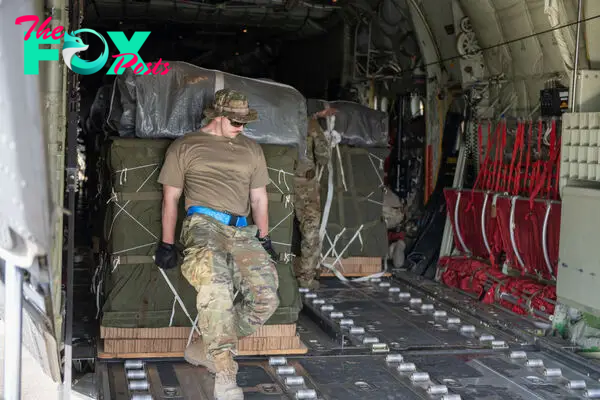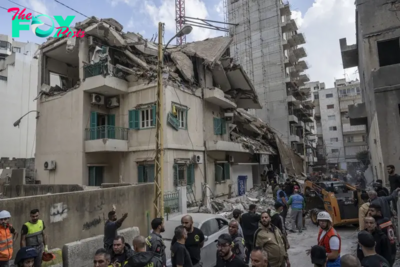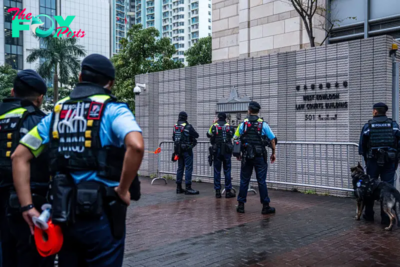World News
‘Unsafe, Ineffective, Undignified:’ Why Food Airdrops Are Falling Short in Gaza
After several days at sea, a Spanish ship carrying 200 tons of vital food aid is anticipated to arrive on the coast of Gaza. The mission, which was organized by the U.S.-based charity World Central Kitchen in partnership with the Spanish charity Open Arms, the United Arab Emirates, and Cyprus (from which the vessel set off), marks the first maritime shipment of humanitarian aid to Gaza since Israel’s bombardment of the Strip began. The goal, World Central Kitchen founder José Andrés says, is “to establish a maritime highway of boats and barges stocked with millions of meals continuously headed towards Gaza.”
The need for these kinds of efforts is immense in Gaza, where starvation has become a weapon of war as Israel continues its efforts to root out Hamas from the Strip in retaliation for its Oct. 7 massacre. Gaza’s more than 2 million inhabitants, the majority of whom are facing emergency- and catastrophe-levels of hunger, have paid the price. As warnings of famine grow louder, so too have the calls for more extreme interventions. Earlier this month, the U.S. began conducting its first airdrops of food aid, parachuting thousands of meals along the coast and in the north of Gaza. President Biden subsequently announced plans to establish a temporary port along the coast of Gaza in order to allow more humanitarian aid to reach the besieged enclave by sea. (In the current absence of a port, which is expected to take months to build, World Central Kitchen has constructed a temporary jetty to receive its aid shipment.)
Read More: What Gaza Reveals About the Limits of American Power
But humanitarian organizations, many of which have been sounding alarms about the hunger crisis in Gaza for months, are not impressed. They argue that air and sea deliveries are not only an insufficient substitute for humanitarian aid delivered by land, but a dehumanizing one that acts as a distraction to the man-made barriers that have prevented more aid from getting into Gaza in the first place. “There is no good reason why aid cannot access Gaza by road today,” says Ciarán Donnelly, the senior vice president for crisis response, recovery, and development at the International Rescue Committee (IRC), noting that unlike places that are too remote or recently subject to natural disasters, where these kinds of measures are typically deployed, there are already plenty of existing land routes into the Strip. He adds that the introduction of airdrops and maritime routes “are only a necessary reality in a situation in which the powers—and, notably, the Israeli authorities—that have the ability to create conditions for safe and effective distribution of aid are not doing so.”
In some cases, these efforts have even proven to be dangerous. Last week, five people were killed and 10 others injured when a parachuted pallet of aid failed to deploy properly. This week, multiple eyewitnesses reported that an airdrop over northern Gaza caused damage to the Baptist Hospital’s solar panels, which provided a vital source of electricity amid widespread power outages. “Distributing aid from airdrops is unsafe, highly expensive, ineffective, and undignified for the people who have to scramble to receive it on the ground,” Donnelly says.
The IRC isn’t the only organization saying so. This week, 25 NGOs including Amnesty International, Doctors Without Borders, and Oxfam released a statement calling on governments to prioritize securing an immediate and permanent ceasefire and resuming the delivery of humanitarian access through all land crossings, warning that “states cannot hide behind airdrops and efforts to open a maritime corridor to create the illusion that they are doing enough to support the needs in Gaza.”
Israel, for its part, denies restricting the flow of aid into Gaza and has faulted the U.N. for the delivery problems (a charge that the U.N. denies). But both aid organizations and international lawmakers who have visited the land borders with Gaza have observed the extent to which Israeli bureaucracy hinders aid delivery, from the restriction of border crossings (only two of the existing seven are open regularly) to the arbitrary rejections of seemingly innocuous items such as sleeping bags and Health kits. Arvind Das, the IRC’s team lead for the Gaza crisis, says that during his most recent visit to Gaza, he observed “hundreds of trucks” languishing at the Rafah crossing between Egypt and Gaza. In February, the IRC estimates that just 2,300 trucks were able to access Gaza, amounting to just 17 trucks per day—a small fraction of the minimum 500 trucks needed daily to meet Palestinian civilians’ needs. (The U.N. puts the monthly estimate closer to 2,800 trucks, though this is also far below Gaza’s needs.)
But even if Israel were to “flood the zone” with food aid, as was called for this week by U.S. Secretary of State Antony Blinken, that wouldn’t address the other major obstacle to the delivery of humanitarian aid: the war itself. “It’s incredibly unsafe for agencies to operate and incredibly unsafe for civilian populations to be able to access aid,” Donnelly says, noting that this has been the deadliest war for aid workers of any coNFLict in recent memory. “If you can think about the logistics of how you organize a large-scale distribution in such desperate conditions with such little law and order and with active coNFLict and the unpredictable nature of bombing and fighting happening throughout—it puts everybody at great risk.”

That the U.S. and others have had to resort to logistically complicated workarounds demonstrates how futile international pressure on Israel to increase the amount of aid going into Gaza has been. Hamas’s Oct. 7 attack notwithstanding, human rights advocates say that the Israeli government has a legal obligation to ensure unfettered and sufficient distribution of aid into Gaza as the occupying power (though Israel withdrew its military and settlements from the Strip in 2005, it continues to exercise control over its air, land, and sea borders, as well as the supply of civilian infrastructure such as water and electricity). Likewise, the U.S. government has its own legal obligations to ensure that its military aid isn’t used to violate international law.
As well meaning as the efforts to rapidly scale up the amount of aid into Gaza may be, Donnelly warns that absent meaningful pressure on Israel by the U.S. and others to live up to its international obligations (and a willingness to exert their leverage accordingly), they’ll ultimately fall short—or, worse, perPetuate the crisis further.
“Calling for humanitarian access while at the same time putting in place these workarounds sends a signal,” he says, “that the blockade of aid and the perPetuation of conditions that make it impossible for sufficient aid to be delivered and distributed is becoming normalized and legitimates those conditions.”
-

 World News2d ago
World News2d agoWhy New Zealand’s Founding Treaty Is in Focus as Thousands Protest for Māori Rights
-

 World News2d ago
World News2d agoIndia’s Capital Chokes as Air Pollution Levels Hit 50 Times the Safe Limit
-

 World News2d ago
World News2d agoBiden Authorizes Ukraine to Use U.S.-Supplied Long-Range Missiles Against Russia
-

 World News2d ago
World News2d agoIsraeli Strikes in Gaza and Lebanon Kill Dozens, Including Hezbollah’s Spokesman
-

 World News2d ago
World News2d agoWhy India and China Are Finally Starting to Patch Things Up
-

 World News2d ago
World News2d agoFire Engulfs Hospital Ward in Northern India, Killing 10 Newborn Babies
-

 World News3d ago
World News3d agoBen & Jerry’s Lawsuit Accuses Parent Company of Censorship Over Gaza
-

 World News4d ago
World News4d agoPayal Kapadia on Her Gently Radical Drama All We Imagine as Light



























